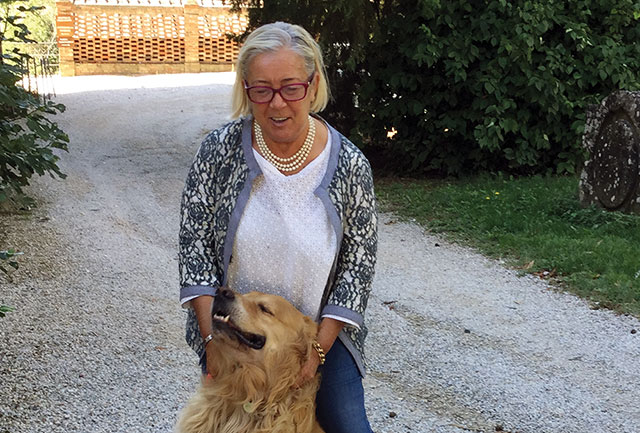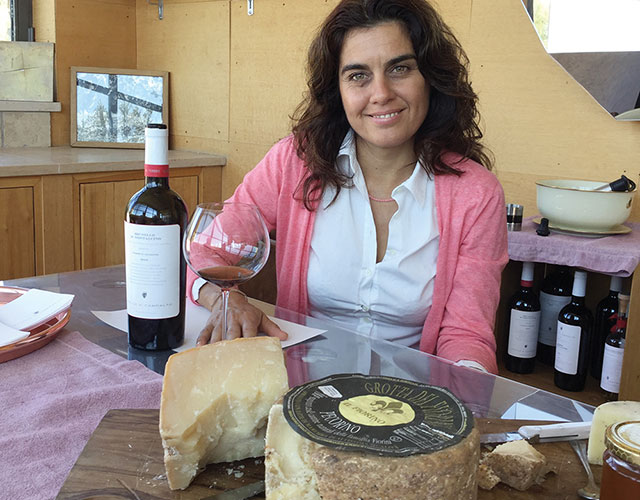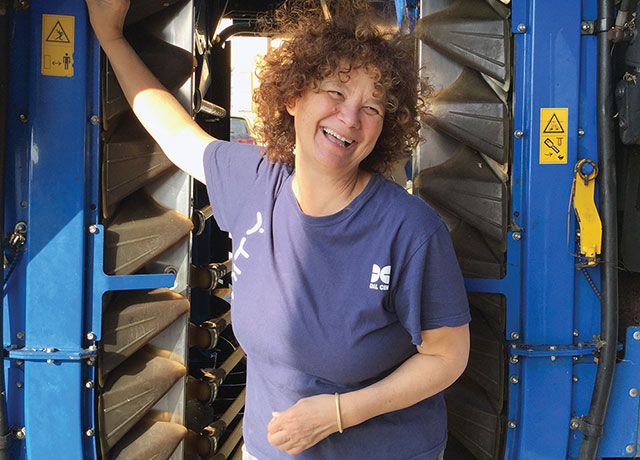Meet four women who are shaking up the status quo in that most traditional of winemaking countries, Italy
by Mary Bailey
Donatella Cinelli Colombini, the prima donna

Donatella Cinelli Colombini with Felix. “We were the first winery in Italy composed of only women.
Donatella Cinelli Colombini makes stellar Tuscan wine, yet her example and influence reaches far beyond the cellar.
Donatella inherited two properties, one in Trequanda and one in Montalcino, in 1988. Trequanda was a working farm but Montalcino was “destroyed,” she recalls.
“The Brunello wine my mother gave me was important but the building in Montalcino was a ruin. I had to invest a lot and I needed a cellar master.
“I asked at the school of oenology in Siena for a female student. They told me women didn’t train to be cellar masters because there was no jobs for them. ‘The wineries don’t trust women cellar masters.’ It was a surprise to me, but I discovered it was a discrimination so old, it was invisible.
“Maybe in the past there was a reason to choose only men; they had to be strong to work in the cellar. I decided to manage my winery as a female winery. We were the first winery in Italy composed of only women.”
So began the Prime Donna Project. Think for a moment the opportunities this decision has made for women in wine, and not just in Italy.
The Project includes her signature Brunello, called Prime Donne, chosen by four female super tasters. “The four ladies want the best,” says Donatella.
Her next project also had long lasting effects. “I decided to do something to convince wineries that wine tourism is good. In 1993 I started a day called Cantina Aperte (open cellar). Now, over 1000 wineries take part in the event on the last weekend in May and many are open year round. Now I teach about wine tourism all over Italy.”
Her advice in trying something new? “Push to be contagious. Be courageous.”
Elena Pantaleoni, the quiet revolutionary

“Wine and books, those are my passions”, says Elena Pantaleon.
I had heard about Elena Pantaleoni, a women making wine in Emilia-Romagna her way. I had heard the wines were fantastic, but I had never come across them. Until last year.
Her father bought La Stoppa in northwest Italy in 1973. He made wine from international varieties, such as Chardonnay and Cabernet, which was the style at the time. “I lived in town and spent the summers here,” she says.
Eventually, Elena had a bookshop in Piacenza. In 1991 she came back to the family property. After a few years it became apparent that the imported varieties were not working. She began a project with wine consultant Guilo Armani, planting Bonarda, Barbera, Trebbiano and Malvasia Candia, the local grape varieties best suited to the climate and soil of the Colli Piacentini region which had been out of fashion for so long.
Along with the viticulture, the winemaking transformed too.
“We are focused on the quality of the grapes and the timing of harvest. If you have healthy grapes, you can use less sulphites and don’t need to add yeast.”
La Stoppa was certified organic in 2008 but they had been working the land in that fashion since 1996. The wines spend several years in barrel (and steel) and in the bottle before they are released for sale.
“We are organic in the vineyard. We leave everything as it has always been. We make long macerations and age the wines. It takes time to make wine well.”
Elena’s quiet and thoughtful approach is apparent both in her wine and in conversation. She chooses to make several wines under the more general IGT classification because she doesn’t think the DOC rules for making Emilia-Romagna wines are related to quality.
She has paved the way for several other like-minded growers and winemakers. She takes us around to taste with other winemakers who share a similar point of view. The wines are lively and delicious. We leave with a newfound appreciation of the region and burning desire to taste more.
Stella di Campalto, Brunello’s new wave

“I am interested in the message of wine in the world.” –Stella di Campalto.
Drive south from Montalcino along a ridge and eventually you’ll get to Stella di Campalto at San Giuseppe. It’s hot, the air, still and lazy, the view over the hills bewitching. All we really want to do is dive into that swimming pool we saw a few kilometres back.
But, once we find the cellar door, meet the dog and start chatting with Stella, we are energized.
“We started harvest a week ago,” she says taking us down into the vineyard close to the winery. “My father-in-law gave me San Giuseppe. It has a strange history. The old owner was the church and the fields were grain, olives, forests. I started this new life when I was young, planting the vineyard in 1996. We had nothing, only the house from 1920, nobody lived there. The first Rosso was 2001, and Brunello in 2004 (released in 2009), 1,000 bottles. Now we make 25,000, between the Rosso and Brunello.”
There are six vineyards (over almost seven hectares) with 12 different soils. The vineyards were certified organic in 1996; Stella uses biodynamic practices (one of the few, perhaps the only, in Montallcino). “Organic is about putting things on the land, biodynamic is about harmony. It’s not just about the farm, what we do here affects everyone.”
Her approach is instinctive and collegial. Stella created SPA (sangiovese per amico) with fellow Brunello producers Pian dell’Orino and Podere Salicutti to heighten awareness of the different cru of Montalcino.
The wines? They have an expressive, ethereal quality that stands out among the best Brunello.
“Most important is the drinkability. My mother taught me that.”
Paola Rinaldini, force of nature

Paola Rinaldini, passionate Lambrusco maker.
Paola Rinaldini’s joy is infectious. As we walk through the vineyards she keeps up a rapid patter about family, the vines, the soils, the state of the market (Japan is very good). She talks about the different varieties of Lambrusco they grow. One of them is the rare PJCOL(Picol) Ross. Low yielding, not suitable for high production wines, so hard to grow it was practically endangered. Her father discovered a few rows when he bought the estate. The vines have not only survived, but have thrived and Rinaldini is one of the few producers of this rare wine.
Lambrusco, the fizzy wine of the Po Valley, is not taken all that seriously for the most part. By making such high-quality wines Paola is saying take another look at the region and its wines. For example, Rinaldini’s Picolross Lambrusco is made in the traditional method, deeply coloured, tannic and savoury, it is just delicious.
Interestingly, Rinaldini machine picks (not everything, and not the Picol Ross) and has been doing so for 30 years. I take a close look at vines that were machine picked a few days before.
They look amazing, not the least beat up. Paola says it’s the skill of the driver, her son Luca. I think that machine knows better than to mess with Paola’s grapes.